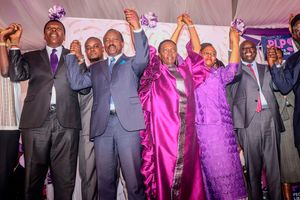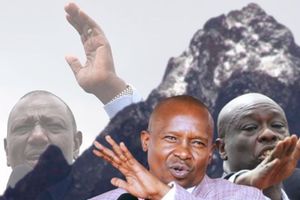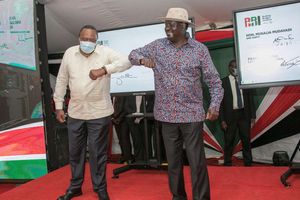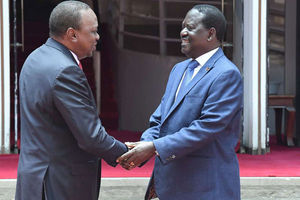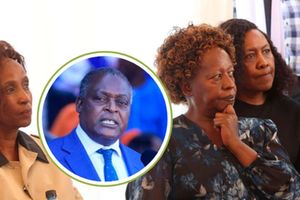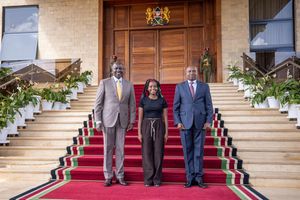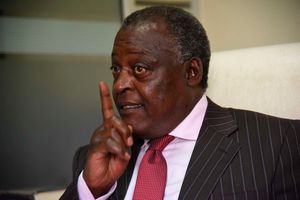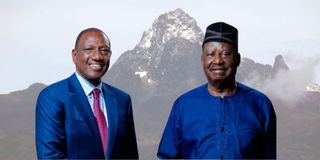
President William Ruto and ODM leader Raila Odinga.
Whether it's a conspiracy by the troika of fabled Greco-Roman destinies or not, President William Ruto's first term in office mirrors that of the man in whose cabinet he served, Stanley Emilio Mwai Kibaki.
The unfolding events signal the country could be trapped in a time warp, with most political developments drawing a parallel to the mood in 2005 leading up to the divisive 2007 General Election that witnessed widespread violence in the aftermath.
Like the case 20 years ago, Mt Kenya, which found itself besieged seeking to help President Kibaki retain power, now also finds itself facing a campaign to isolate the region that this time is fighting to dislodge President Ruto after a bitter fallout with his former deputy Rigathi Gachagua.
The rivalry between Ruto and Gachagua is reminiscent of the power struggle between Kibaki and Raila that sowed the seeds of ethnic divisions that inflamed political passions to dangerous levels.
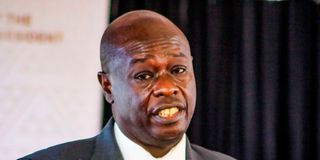
Former Deputy President Rigathi Gachagua.
Kibaki was humiliated in the 2005 constitutional referendum.
His 'Yes' side was roundly rejected by the people through a no campaign led by members of Kibaki’s own cabinet, including Raila, who had disagreed with him.
For a sitting president, that level of failure comes with an enormous credibility deficit.
In some democracies, this would have led to resignation. The ever-stoic Kibaki stayed put and made a new patchwork of government known as the Government of National Unity.
Similarly, last year the country rejected Ruto's Finance Bill, a document the masses felt would only increase the cost of living. Bowing to public pressure, which culminated in the invasion of Parliament by Generation Z on June 25, Ruto backed down. It was a precedent-setting move by a sitting president.
Quell the anger
As well as refusing to assent to the bill, which would have made it law, the president sacked all his ministers in an attempt to quell the anger. In both cases, Mount Kenya is at the centre of the ring, fighting to retain power in 2005 and now to regain it.
Only the Prime Cabinet secretary, Musalia Mudavadi, survived the purge and became the 'minister general', presiding over all business in the interim.
“I have, in line with the powers given to me by Article 152(1) and 152(5)(b) of the Constitution and Section 12 of the Office of the Attorney-General Act, decided to dismiss with immediate effect all the Cabinet secretaries and the Attorney-General from the Cabinet of the Republic of Kenya except the Prime Cabinet Secretary and Cabinet Secretary for Foreign and Diaspora Affairs,” the president announced.
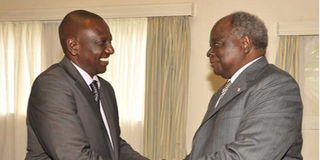
President William Ruto with former president Mwai Kibaki.
Then Deputy President Rigathi Gachagua easily escaped the stiletto, because presidents can't fire their deputies on a whim. That power lies with the legislature. He would meet his Waterloo months later when the bicameral parliament impeached him last October.
But Ruto and his handlers - under siege, it seems - only ran to the library for Kibaki's playbook when he announced on July 11. After losing the referendum, Kibaki showed all his ministers the door, with Odinga, the leader of the 'No' camp, among the casualties.
“Following the results of the Referendum, it has become necessary for me, as the President of the Republic, to reorganise my government to make it more cohesive and better able to serve the people of Kenya. I have directed that the offices of all Ministers and all Assistant Ministers become vacant. Consequently, the occupants of the said offices cease to hold their respective offices with immediate effect,” Kibaki said on November 23, 2005, a day after the results were declared.
Volatile political ecosystem
In the loyal Prof Kithure Kindiki, Ruto has the equivalent of Uncle Moody Awori, a man Kibaki tapped to stabilise a volatile political ecosystem (though he'd been an insider all along, a member of the Narc summit). Kindiki is not seen as cantankerous as Gachagua, sometimes with a deceptive demeanour of lacking ambition beyond the present, something Gachagua couldn't hide.
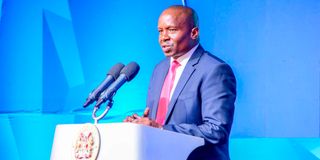
Deputy President Kithure Kindiki.
Although Kibaki's margin of victory over his closest challenger, Uhuru Kenyatta, in the 2002 presidential election was greater than Ruto's 233,211 votes against Odinga, it's been the same baptism of fire for the scion of Kamagut.
Like Kibaki, Ruto had the pulse of the mountain, or Murima, in the run-up to the election and for a few months afterwards. Indeed, the region even defied its kingpin, Kenyatta, to vote for him in 2022, but that's no longer the case. The fallout has been unprecedented, and Odinga's embrace, an act of guilt by association, has only heightened the threat matrix. They accuse the president of using their son, Rigathi Gachagua, to climb the ladder to the House on the Hill, only to lead the charge to impeach him months later.
Wamunyoro, as Gachagua is now known on the streets, has promised sweet revenge. Odinga and crew promised Kibaki the same in 2005.
“We are going back to the people and we shall be vindicated,” Odinga declared then.
"We will make whatever sacrifices necessary to ensure that William Ruto is a one-term president," promises Gachagua.
Any chance of reconciliation between the two now is a Sisyphean task. They have crossed the Rubicon, it appears.
The same winds that blew in 2005 haven't abated. Just as it was a crusade for constitutional change, so it is now.
One of the points on which the president and Odinga have agreed is the implementation of the National Dialogue Committee (Nadco) report, which seeks to reintroduce the positions of leader of the official opposition and prime minister. Odinga and his team accused Kibaki of reneging on a promise to create a powerful prime minister, which led them to shoot down the Bomas draft.
Nadco was a product of an initiative to address several opposition demands in the aftermath of the disputed 2022 presidential election, in which Ruto and Odinga were the main players. It was preceded by bloody protests that left several people dead.
Betrayal is a common thread in both cases. Gachagua accuses Ruto of 'use and dump'. Those who rallied around Odinga levelled similar charges against Kibaki.
“Here was a man we lifted up, campaigned for when he was in a wheelchair after a near-death accident, was elected president and then kicked us in the groin," they said.
Odinga's Liberal Democratic Party (LDP), which held a crucial minority of seats on the government benches, felt betrayed by the Kibaki side.
Inciting the masses
Now the Gachagua case has snowballed into an anti-Ruto maelstrom that has sent the president's men back to the drawing board. As he prepares to visit the region tomorrow (Tuesday), Gachagua is already inciting the masses against him.
"If you want to listen to the lies, charge a high price because lies are bad. Do not accept less money to listen to the lies," the former DP said in Naivasha on Saturday.
Kibaki had to deal with the same thing in the last two years of his regime, before the bloody 2007 elections after the Odinga-led axis brought him hell. He had little or no time to work. The former DP has promised his supporters a new political party come May, a vehicle around which he intends to coordinate his anti-Ruto activities ahead of the 2027 polls. With more than two years to go, the country has been forced into premature campaign mode.
Like Kibaki, Ruto has reduced his travels to central Kenya following the spat with Gachagua. Kibaki hardly set foot in Odinga's Nyanza bastion after 2005. While Ruto's decision to visit the region this week may appear bolder, the enthusiasm the trip would otherwise have generated has waned, a public indictment of him for sacking their son. How this plays out will determine whether or not he returns before the next election.
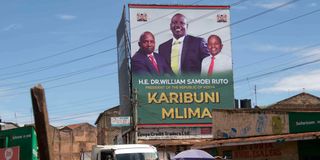
A billboard featuring photographs of President William Ruto, Deputy President Kithure Kindiki, and Mathira MP Eric Wamumbi stands in Karatina Town on March 25, 2025, welcoming the President to the Mt. Kenya region.
During the referendum campaign, Kiraitu Murungi-He of the Happiness Society of Kenya and an apparatchik of the National Rainbow Coalition declared, 'We will shake this country from every corner', only to be pulverised at the polls by the 'No' camp.
Prior to the sacking of his cabinet, the same hubris that characterised Kibaki's inner sanctum was evident among politicians associated with the Kenya Kwanza coalition, making them even more unpopular with the masses - lavishing millions in cash at public functions at a time when the critical masses were suffering from biting poverty.
The No, or Orange, camp would morph into a full-fledged political party, ODM K, and eventually ODM - the second largest in terms of elected representatives in Parliament, local assemblies and the Council of Governors. The ruling UDA boasts a majority. There is talk of registering an 'Inject Party' linked to activist Morara Kebaso, a leading figure in the Gen Z movement. Inject was one of the slogans of the anti-government mobilisations at the height of the weekly protests.
In a case of history repeating itself, the country has in a sense witnessed the regrouping of the ODM Pentagon, an elite club of honchos that ran the Orange Party, albeit without some of its former members like the late Joe Nyaga and Najib Balala. Led by Odinga, Ruto and Mudavadi were its members, and now they are all in it together again.
The events of the Gen Z movement threw the regime off balance. Not only did it force Ruto to shake hands with Odinga, it also led to a reorganisation of the government to accommodate Odinga's allies, resulting in a bloated government. Seven new ministries have been created. Kibaki was forced to make similar adjustments. He had 40 ministers. Now the constitution limits the number to 22.
The result would change the country's political landscape forever two years before the 2007 elections, making Kibaki more or less a lame duck. In an attempt to regain his footing, and in a state of panic, he resorted to a series of events, culminating in the sacking of the entire cabinet, and subsequently appeared to have isolated almost half the country.
Sadly, the events of 2005 brought the country to the brink of an abyss, leaving hundreds dead and hundreds of thousands uprooted from their homes.
Exactly two decades ago, at least six politicians were dragged before the International Criminal Court in The Hague and charged with crimes against humanity. The charges were later dropped due to insufficient or lack of evidence. There are growing calls for a de-escalation of politics, the lifeblood of government, to avoid a repeat of what happened after 2007.

